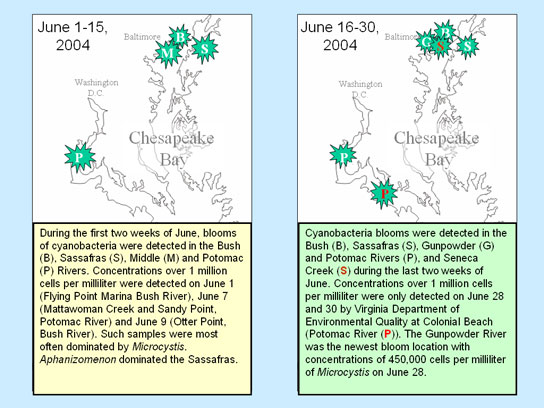|
||
A water sample collected on June 28 from the Gunpowder River showed the blue-green algae Microcystis dominating the phytoplankton community with concentrations of 450,000 cells per milliliter. Microcystis was present at low concentrations (5,724 cells per milliliter) in a sample collected at the same location on June 22. The June 28 sample provides the first bloom detection of Microcystis in 2004 for the Gunpowder watershed and expands the range of tributaries where blue-green algal blooms have been observed (see Figure 1). Maryland Department of Natural Resources collected the sample during routine monitoring investigations while tending to the Aberdeen Continuous Water Quality Monitoring station located on the lower end of the Gunpowder River. 
A sample from the Bush River collected at the Lauderick Creek Continuous Water Quality Monitoring station measured 15,105 cells per milliliter of Microcystis, similar to concentrations found at the same site on June 14 (see HAB News from June 24, 2004: "Blue-green algae (Cyanobacteria) blooms continue on the Bush River; Seneca Creek (Baltimore Co.) new bloom location."). Samples collected by DNR on June 24 from the Sassafras River near Galena in Woodland Creek showed the blue-green algae Aphanothece (pronounced a-fan-owe-theek-ee) was dominant at 392,200 cells per milliliter in one sample and 39,750 cells per milliliter in a second sample. This is unusual since the algae is better known for being associated with the sediment than floating in the water column. Another blue-green alga, Merismopedia, was common in both samples. The sample sites are well upriver and included a pond-like habitat where the invasive aquatic vegetation species, water chestnut, was being harvested during DNR invasive species control efforts. Virginia Department of Environmental Quality (VADEQ) working with Dr. Harold Marshall of Old Dominion University identified a Microcystis bloom at Colonial Beach, VA along the western Shore of the Potomac River downstream of the Rt. 301 Bridge on June 24. A sample collected at the beach on June 25 measured 85,000 cells per milliliter dominated by Microcystis. However, on Monday, June 28, VA DEQ measured 1.8 million cells per milliliter in a bloom sample. VADEQ working with the Colonial Beach Town Manager closed the beach Tuesday June 29. On June 30, samples collected along the beach ranged in concentration from 4000 to 1.9 million cells per milliliter keeping the beach closed to swimming as of July 2. The most concentrated bloom waters have shifted up and down the beach region in response to wind, currents and tides. Similar patches of bloom waters have been identified on the Potomac River at Mattawoman Creek and near Sandy Point in Charles County on the mainstem Potomac River since June 7 (see HAB News from June 11, 2004: "Blue-green algal blooms expanding in Chesapeake Bay tributaries since June 1.", and DNR's Press Release for this bloom event). Maryland Department of Natural Resources (DNR), in coordination with Department of the Environment (MDE), Department of Health and Mental Hygiene (DHMH) and VADEQ continue to monitor blue-green algal (i.e. cyanobacteria) blooms in tidewaters of Chesapeake Bay. Pockets of blue-green algal blooms may be encountered during boating and other recreational activities. People should take common precautions to reduce the risk of illness or discomfort related to blue-green algal blooms:
Please note that illness associated with harmful algal blooms is now a reportable illness so physicians should be reporting these to local health departments. The MD DNR in coordination and cooperation with DHMH and MDE will continue to monitor all blue-green algal blooms throughout the state. For up to date information on all of Maryland's harmful algal blooms and water quality, please visit Eyes on the Bay |
